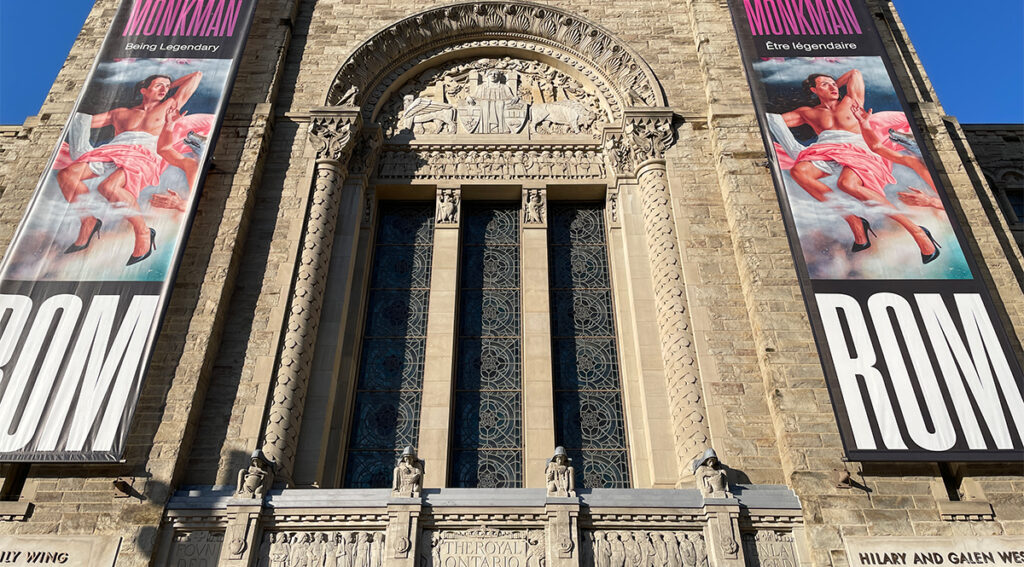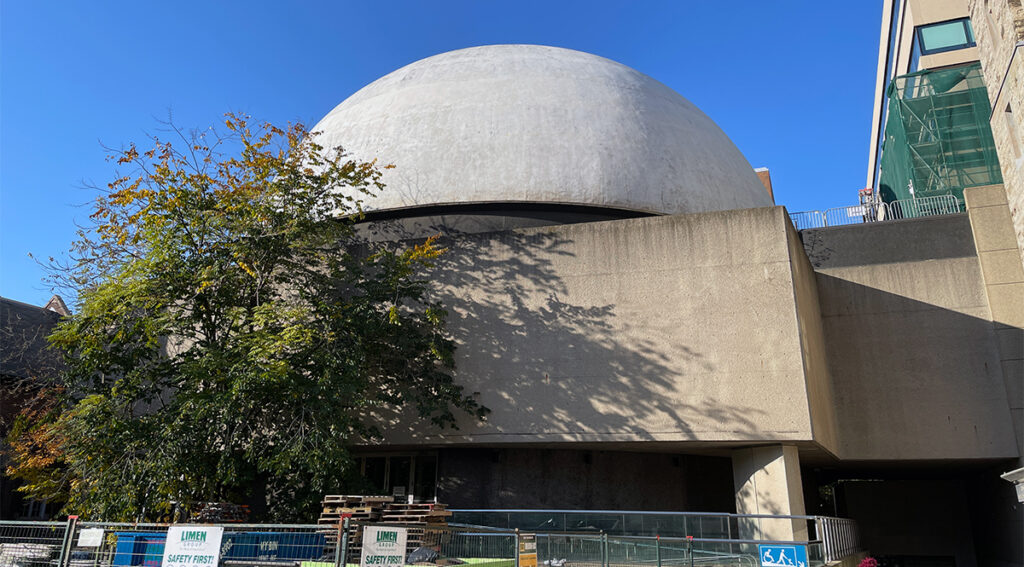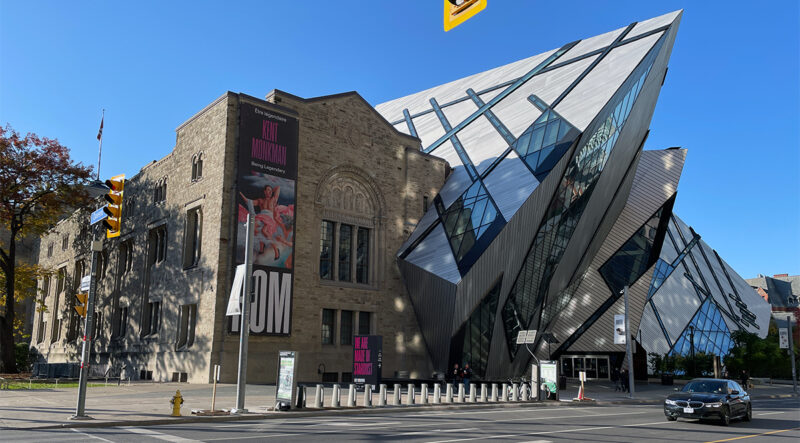With so much history under one roof, it’s hard not to believe there aren’t a few attachments to the artifacts inside.
Every autumn, the Royal Ontario Museum takes its members on a tour of the building, sharing spooky tales, but for ROMKids Manager and Camp Director Kiron Mukherjee, the experiences he’s had and shared with visitors resonate throughout the year.
Mukherjee offers hour-long tours with the kids at camp, members of the board of governors, as well as museum donors. He’s been working at the ROM for 18 years.
“I never could leave the place, and when I was young, I started hearing about the different stories and putting them together,” he said, during an October phone conversation.
There’s a hint of skepticism in his voice, but also a hint of enthusiastic curiosity as he reveals his passion for a good ghost story.
“I don’t necessarily believe in ghosts, but I do believe people and places can be haunted,” he said. “What’s compelling for me about ghost stories, and I love them, is I love a good story that dives into the history of that place or that person.”
There’s something real to all the experiences people have at any haunted location, Mukherjee admits, and the ROM is certainly a location that has its ghostly lore. From the first curator, Charles “Trick” Currelly, and his music filling the halls to Celeste, the young girl wandering the planetarium, to the mysterious woman who stalks the corridors of the European gallery, there are plenty of resident spirits.
Seika Groves, an archaeologist and historian who is a former employee of the ROM, started as a volunteer when she was a teenager, and she too has plenty of stories to share when it comes to the resident spirits.
She took archaeology at the University of Toronto and worked in the Egyptology department. A good portion of her work was handling the mummified remains of Egyptians. She even worked with renowned Egyptologist, Dr. Gayle Gibson. She left in 2004 but not without mentally noting all of the “strange spots” from the storage areas in the basement, to the rotunda to the planetarium.
Throughout her time at the museum, the medium has never seen an apparition, but she could see them in her “mind’s eye” or her peripheral vision.
“There have been several times that I have been in the museum, early in the morning because I was doing prep work for the schools coming in … sometimes it was pretty quiet and that’s when you get an appreciation for what’s there,” she recalled, during an October phone conversation. “A few times I felt as if I saw someone out of the corner of my eyes. It was more shadowy than anything up in the rotunda.”
She added she feels that some of the artifacts in the building come with their own attachments.
“There’s a fine line to tread before people go, ‘What are you talking about?’” the 59-year-old said, with a laugh. “We’re science-minded people, right? Or we’re supposed to be.”
Currelly is still on the job, even in the afterlife
The ROM has its strange spots and the former location of Currelly’s office in the rotunda.
Currelly was keen on making Toronto a world-class city, and succeed at that, in his view, it needed a world-class museum.
He helped start the Royal Ontario Museum. He was a University of Toronto alum who was trained as a Methodist minister. Instead, he devoted his life to archaeological work, often travelling the globe to add to the extensive collections of affluent people like Sir Byron Edmund Walker.
Walker spearheaded the campaign to found a world-class museum in Toronto, and helped fund Currelly’s travels to collect pieces for the would-be institution.
In 1914, Currelly was appointed director of the Royal Ontario Museum of Archaeology and held the job title until his retirement in 1948. The ROM was originally an assembly of different museums that came together. There was a paleontology, geology and world cultures museum that was combined with archaeology.
“You could see it in the building,” Mukherjee said, adding that Currelly was a proponent for the museum.
The Queen’s Park entrance was built during the Great Depression through a make-work project. All the masonry was quarried from Toronto’s Brickworks, and put in place by hand, as to ensure longer hours for the workers.
During that process, Currelly was able to design his own office. Above the entrance, and below the golden mosaic design of the ceiling, there was a balcony to his office.
“(Currelly) had the belief that he wanted to see everyone coming into the museum,” Mukherjee said, adding Currelly was known to stand out on the balcony during the day, “soaking it all in”.
It wasn’t uncommon for him to spend the night at the ROM because he loved it so much. He had a cot; his pajamas and he would turn the music up in his office and he would go for a stroll throughout the museum.
“If you were a security guard, a curator working late or housekeeping, if you heard music, you knew Currelly was walking around,” Mukherjee said.
After the construction of the Michael Lee-Chin Crystal, the balcony became inaccessible. And it’s covered by a hatch. If you’ve got a flashlight, and don’t have claustrophobia you can wiggle your way through an opening to come upon a chair that eerily sits facing the entrance. The original wallpaper is there, as is Currelly personal bathroom.
“There’s a little bit of his office there, but most of it’s gone,” Mukherjee said.
Then there’s the ghost story. People have often reported seeing a man late at night, rounding the corners. There would also be music playing in the background.
Mukherjee shared one story about two teachers working in the long-since-gone education wing one night in the late 1980s or early ‘90s. One of the teachers was writing out her learning goals for the next day, and out of the corner of her eye, she sees a man peeking.
“She goes back to her work and realizes ‘Who’s here?’ Well, it’s just her and the other guy. So, she gets up and goes to the other office,” Mukherjee recalled. “She says, ‘Hey, did you see that man?’ and the other teacher says, ‘No, can you describe him?’ ‘Well, it was a man in pajamas.’”
The other teacher brushed it off with a sense of humour, adding that it was just Currelly checking in on them.
Mukherjee admitted that there hasn’t been a sighting of the former director for quite some time. Perhaps the renovations and introduction of the Crystal have ended his late-night sojourns with a jazz soundtrack.

The Queen’s Park entrance of the Royal Ontario Museum. It is said that in the rotunda, Charles “Trick” Currelly would take in the sights and watch everyone as they arrived from his office balcony.
Planetarium’s Celeste-tial entity
The McLaughlin Planetarium changed hands in 2009. Originally opened in October 1968, the planetarium was forced to close in 1995 due to provincial budget cuts to the museum.
The property and the building were sold to the University of Toronto in 2009 and plans for the site were released in 2014.
According to John Robert Colombo in Haunted Toronto, no sooner than the planetarium’s opening, volunteer guides began spotting a young girl in a long, white dress, with blonde ringlets in the building.
Mukherjee recalled that the staff referred to the resident spirit as Celeste, due to the celestial nature of the building. And there are as many stories as there are stars about the young girl.
“One of our old teachers used to run the planetarium and one of his assistants was doing the rounds to make sure that everyone was in the theatre and he sees a little girl,” Mukherjee said. “He asked her, ‘Where is your family?’ and he turns around only for her to disappear.”
One story, shared for decades among the ROM Camp counsellors, has the staff adjusting the ROM theatre being closed by watching movies with the kids in a separate theatre in the planetarium’s sub-basement.
“One morning, a five-year-old goes to their counsellor and says, where was the girl sitting beside me? So, the counsellors being good at their jobs, they start going through their attendance, making sure all their kids are there,” he recalled. “Every single child was at camp.”
The alleged backstory was that Celeste lived in a farmhouse on the property. According to the ROMKids Tumblr page, she had been tucked into bed one winter night by her father, who went to check on the animals. When he hadn’t returned to the house, Celeste got on her nightgown and boots and ventured out in the storm to find her dad. She eventually froze to death and her father came across her body after wrapping up his rounds.
Regardless, there has been a playful side to the girl, some have witnessed. In other instances, it is said she plays with the camp toys that were put away by counsellors. After several occurrences with toys being strewn about overnight, counsellors began leaving the toys out for Celeste to play with.
Celeste has been seen within the last 10 years. The unfortunate witness was a painter, who was working overnight at the Queen’s Park entrance.
“He was finishing up and was about to go down the heritage stairs to leave when he sees a little girl just standing in the Queen’s Park entrance area. He phones security, and security says they will send somebody up there, but I think they’ve heard a few reports about it,” Mukherjee recalled. “The next day, the painter checks in with a project manager and says, ‘I’m never going to paint here again’.”
Before the construction of the museum, there were other buildings on the property, including the Argyle House, which is where the Currelly Gallery stands now. And the future site of the planetarium was also home to family.
“In some of the old photos of when the museum was being built, you can sort of see where the planetarium is now. There was another house,” Mukherjee admitted. “One day, when my life slows down, my goal is to go to the reference library and dig in.”
Groves acknowledged that there were people on the site before the construction of the ROM, but she never picked up on Celeste because she had not spent a lot of time at the planetarium.
But she did find the driveway off of Bloor Street, between the Royal Conservatory of Music and the Royal Ontario Museum very interesting. She used to park her car in a lot back there, and she would
“I don’t know if it’s the same little girl, and I never thought much about it, but sometimes when I would get out of my car, and sometimes I would get a sense that someone was there,” she recalled. “It was always like you were being watched. It was outside and between the two buildings.
“I feel there is a family burial in that location that has been built over, or non-existent.”
Groves admitted she’s a bit skeptical about the story tied to the young girl. Even as a medium, Groves said, the spirit can only show how they died, but oftentimes they don’t know how they passed.

The former McLaughlin Planetarium sits nestled between the Royal Ontario Museum, the University of Toronto’s Faculty of Law and the MacMillan Theatre.
Unexpected guest in European exhibit
“You don’t often hear about new ghosts,” Mukherjee said, his voice thick with enthusiasm. And he goes into full story mode over the phone about the “European lady” that has been spotted in one of the eerier parts of the museum: the European gallery.
“It’s spooky to begin with because all the lights are off, and it’s a little bit colder. There is no natural light, and there’s a lot of automated music that comes on. But at night time, it doesn’t really turn off at night, it just goes lower,” he narrated. “Do you remember the whispers from ‘Lost’? You’ve been primed to feel uncomfortable. You’re flashing your light and there are all these silvery, reflective objects, so it looks like you’re seeing things everywhere.
“And there’s a patch of wooden floor that creeks as wooden floors do, and so the guard goes around, does his patrol, and comes back into the main section where the knights (are) and he sees a woman standing right in front of him.”
Naturally, the guard says, “Excuse me, ma’am, the museum is closed.”
Of course, it is, Mukherjee says, with a tinge of sarcasm. It’s 3 a.m. But, with every ghost story, a brief moment of looking away, and a return to the site, and the revenant is gone.
To this day, people have reported hearing someone walking with them along the wood floor section of the exhibit.
“If you could imagine a dress with a lot of ruffles in it; when you walk, the fabric scratches against itself and makes a noise. So, they would hear footsteps accompanying this fabric sound,” Mukherjee said.
Groves has felt the odd, oppressive energy in the European gallery.
“For me, I feel that’s more of a how the gallery is set up,” she admitted. “There is not a lot of airflow in there either, in terms of openness.”
She said it’s good to exercise skepticism when going into a location, going as far as “picking apart everything before coming to a conclusion”.
At the end of the tour
“What I love about the ROM ghosts is when you do the full experience, is you get to learn about our architecture and our history,” Mukherjee said. “You get to learn about these stories that have persisted through time.”
Currelly, Celeste and the European lady may be the main attractions that haunt the corridors and exhibits, but Groves said she sensed more than those usual suspects inside the building.
“I can still walk through the museum and pick up on all those spots when I was working there when I was there,” she admitted, adding the retail storage area across from the cafeteria in the basement is one particular spot she’s sensed being active.
But she’s never really had an opportunity to investigate further.
“There are pockets and areas in the museum that retain something,” she said. “It’s one of those buildings where, if you don’t have your wits about you, you could easily be scared.”
Regardless of the resident spirits, or any spooky goings-on, Mukherjee loves the lore associated with the ROM.
“I never could leave the place, and when I was young, I started hearing about the different stories and putting them together,” he said. “Since then, I do ghost tours with our kids at camp. I do them with our governors.”

